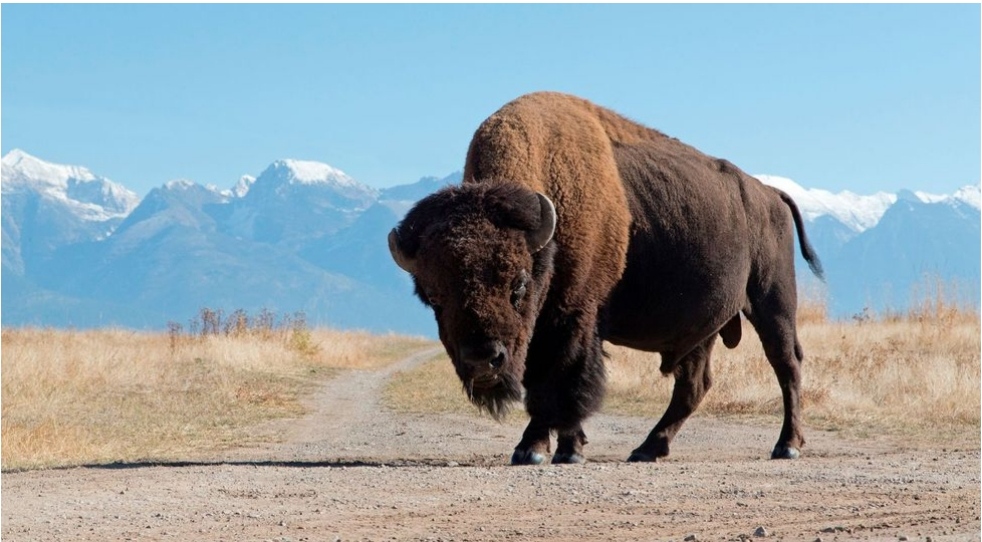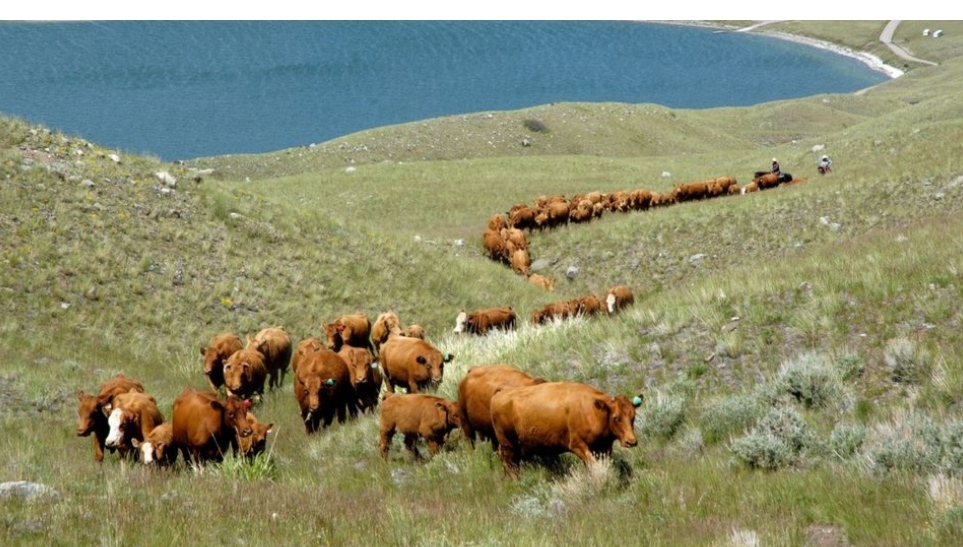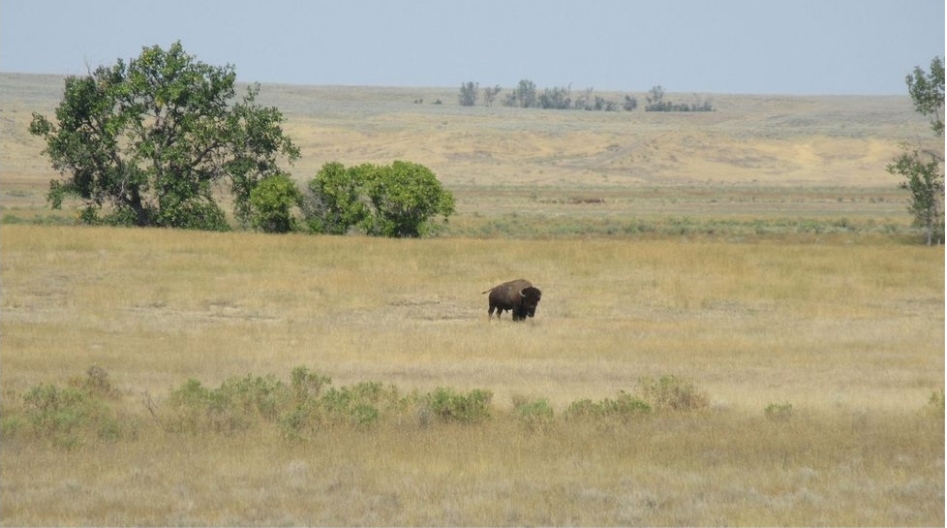Why grazing bison could be good for the planet?

By Christopher J Preston
American bison were hunted almost to extinction by European settlers. Now making a comeback, they could help reverse damage to prairies from decades of poor management.
It takes mettle to live on Montana’s shortgrass prairie. It’s dry, windy and a long way from anywhere. In summer, temperatures can top 100F (38C). In winter, the mercury plunges to -50F (-45C). In some spots, it is more than an hour’s drive on gravel roads to buy a loaf of bread. When you get back, grasshoppers start cannibalising their brethren impaled on your car grille.
The indigenous Blackfeet, Nakoda and Gros Ventre peoples successfully adapted to the harsh environment over many centuries. More recently, a handful of hardy white settlers managed it too. Both left their mark on this forbidding land with fire, arrows and the plough. The shortgrass prairie makes up 71 million hectares (27,413 sq miles) of remote land straddling the US/Canadian border to the east of the Rocky Mountains. This rare habitat is in ecological decline. For the last 150 years, wildlife have surrendered the prime habitat to cows. Crested wheatgrass, a non-native plant seeded by European settlers for their cattle, paints swathes of land yellow in summer.
Today, though, parts of the landscape are being shaped by a different resident. This one sports a pair of black horns and a thick cape of curly brown hair.
SIGN UP TO FUTURE EARTH
Sign up to the Future Earth newsletter to get essential climate news and hopeful developments in your inbox every Tuesday from Carl Nasman. This email is currently available to non-UK readers. In the UK? Sign up for newsletters here.
The North American plains bison has a long history here, albeit one that suffered a brutal interruption. For a century and a half, their distinctive humped shoulders and bearded faces were missing from America’s grasslands.
Tribes and conservation organisations have recently started bringing the bison back. And scientists studying the returns are discovering that getting the 2,000lb (900kg) grazer back in its native ecosystem could be key to the future of the prairie. When I visit one of these projects in summer 2023, wilting in the searing summer heat of the scorched prairie, I wonder what a giant, fur-covered herbivore is doing to help.
The bison’s biggest service, I soon find out, is to assist the prairie in holding onto its water. Bison on the shortgrass prairie send a strong message about the importance of native grazers for landscape resilience. They may offer the prairie a lifeline as climate change tightens its grip.

Cattle tend to congregate near water sources and if not moved regularly can destroy waterside vegetation (Credit: Getty Images)
Hila Shamon, a research ecologist with the Smithsonian’s National Zoo and Conservation Biology Institute in Washington DC, has spent five years tracking the ecology of the remote grasslands.
She partners with American Prairie, a conservation organisation with parcels of land on either side of the million acre Charles M Russell National Wildlife Refuge, to study how bison are changing the ecosystem.
Shamon spends her field season crawling across American Prairie property measuring everything from vegetation density and species diversity to the habits of grassland birds and prairie dogs.
Shamon recently co-authored a study on prairie streams which suggests bison do something remarkable in this hostile environment. “There is no doubt, year-round grazing of bison is good for the landscape,” she tells me. Bison, it turns out, have an ingrained capacity to boost biodiversity.
Plains bison co-evolved with the short-grass prairie. In the 12,000 years since the end of the Pleistocene, they have proven themselves to be potent ecosystem engineers.
An adult bison eats about 25lb (11kg) of grass a day. The grasses adapted to their foraging. Vegetation across the plains uses the nutrients in their dung. Birds pluck their fur from bushes to insulate their nests.
Bison also shape the land literally. They roll in the dust and create indentations known as “wallows” that hold water after rainstorms. After the bison move on, insects flourish in these pools and become a feast for birds and small mammals. Pronghorn antelope survive by following their tracks through deep winter snows.
Today, however, bison are getting a second chance
Plains bison spent thousands of years engineering a distinctive grassland ecology from Northern Canada through Montana to Mexico. But more than a century ago, this influence abruptly stopped. A few decades of slaughter led bison numbers to plummet from 60 million to barely 800 living wild in the US and Canada by 1889. Market forces and government policy replaced bison and native people with ranches, white settlement and cattle. For a hundred years, cattle claimed the prairie as their own. But while they were easier to turn into steaks, they were not as finely tuned for prairie life.
Today, however, bison are getting a second chance. Tribal reservations are at the forefront of their recovery, taking excess bison from Yellowstone National Park and restoring them to treaty lands. American Prairie is also playing a part, buying ranches and returning bison to places where cattle were once king. About 30,000 bison now exist in conservation herds in various parks and protected areas across the country. More than 10 times that number exist on bison farms.
Scientists like Shamon are watching it all closely to see how the return of bison affects the land.
“Cows don’t move as much,” Shamon says. When the weather gets hot, they gravitate to the creek bottoms for shade and the cooling water. When it’s cold, cows hunker down behind creekside shrubs to shelter from the wind.
An adult bison eats about 25lb (11kg) of grass a day. The grasses adapted to their foraging. Vegetation across the plains uses the nutrients in their dung. Birds pluck their fur from bushes to insulate their nests.
Bison also shape the land literally. They roll in the dust and create indentations known as “wallows” that hold water after rainstorms. After the bison move on, insects flourish in these pools and become a feast for birds and small mammals. Pronghorn antelope survive by following their tracks through deep winter snows.
Today, however, bison are getting a second chance
Plains bison spent thousands of years engineering a distinctive grassland ecology from Northern Canada through Montana to Mexico. But more than a century ago, this influence abruptly stopped. A few decades of slaughter led bison numbers to plummet from 60 million to barely 800 living wild in the US and Canada by 1889. Market forces and government policy replaced bison and native people with ranches, white settlement and cattle. For a hundred years, cattle claimed the prairie as their own. But while they were easier to turn into steaks, they were not as finely tuned for prairie life.
Today, however, bison are getting a second chance. Tribal reservations are at the forefront of their recovery, taking excess bison from Yellowstone National Park and restoring them to treaty lands. American Prairie is also playing a part, buying ranches and returning bison to places where cattle were once king. About 30,000 bison now exist in conservation herds in various parks and protected areas across the country. More than 10 times that number exist on bison farms.
Scientists like Shamon are watching it all closely to see how the return of bison affects the land.
“Cows don’t move as much,” Shamon says. When the weather gets hot, they gravitate to the creek bottoms for shade and the cooling water. When it’s cold, cows hunker down behind creekside shrubs to shelter from the wind.
What’s more, the creek is still improving, he says. “Every year the creek gets a little wider, a little more meandery, a little more like a pool and less like a trench.”
***
While the evidence for the benefits of bison is compelling, many cattle-owners think the story needs more nuance. Malou Anderson-Ramirez and her husband run cattle on a ranch bordering Yellowstone National Park, 300 miles (480km) to the south-west of American Prairie. When we talk about grazing and stream health, she inserts an important qualifier.
“It’s not the cow, it’s the how,” she says.
Ranchers have always known that when they have successful wildlife populations they are in a better place to have a successful ranch – Martin Townsend
If you graze cattle carefully, you can avoid the damage that occurs when they are left to their own devices. Anderson-Ramirez reinforces the places she wants cattle to cross a stream with rocks and fences. She pipes creek water into tanks hundreds of feet away to ensure animals aren’t wading into the stream to drink. She lets vegetation rest for several weeks between grazing rotations to give plants time to rebuild their roots. This type of regenerative grazing treats livestock as a tool that can improve the health of the land.
Shamon agrees that cattle can provide benefits in systems that evolved with large herbivores. In a study of grassland birds, she found that, outside of riparian areas, birds benefit almost as much from the presence of cattle as they do from bison. “If you manage the cattle in a proper way and you continue to rotate them, you could get an effect similar to bison,” Shamon tells me.
Kinka shares the view that grasslands need a big grazer, whether that be a cow or a bison. The key is to thwart cattle’s natural inclination to loiter in the water.

Over thousands of years, herds of bison helped to engineer a healthy, vibrant prairie environment (Credit: Christopher J Preston)
Martin Townsend of the Rancher’s Stewardship Alliance in Malta, Montana is helping ranchers implement these better grazing strategies. “Ranchers are very aware of what cows can do to riparian areas if left unattended,” he says. “They know it’s not in their interest.”
Townsend gets grants from state agencies and environmental organisations to defray the costs of wildlife-friendly ranching. “Ranchers have always known that when they have successful wildlife populations they are in a better place to have a successful ranch,” he says. His organisation encourages fences and strategically placed mineral licks to keep cattle away from creeks. They hire the same Montana Conservation Corps workers as American Prairie to build BDAs. The BDAs slow the streamflow down and allow more water to penetrate the soil. This creates greener grass, a benefit to ranchers and wildlife alike, he tells me with a grin.
Conservationists often tout the benefits of bringing back top predators to restore balance to ecosystems. The importance of bringing back large, native grazers is lesser known but equally important. In Kansas, 30 years of bison grazing in tallgrass prairie has been shown to increase native plant species richness. In Europe, it is hoped the restoration of European bison in Kent in the UK will do something similar for ancient woodlands. Across the world, native grazers are ready to slip back into ecosystems to resume their lost roles.
In places where native species reintroduction may be difficult, careful management of livestock can provide some of the same benefits. On landscapes as big as Montana’s prairie, it seems likely there is room for both. People still want to eat Montana beef and ranching has an important place in the region’s culture and economy. But as climate change intensifies, it is worth considering which animals are best adapted to the emerging conditions. Plains bison, frugal around water and constantly on the move, are built for this land. They are also a healthy source of protein. Outside Yellowstone National Park, they are already providing meat to hunters from the tribes. And, on its land, American Prairie is offering 17 permits for bison hunts this year.
***
On my last night at American Prairie, I wake in my tent with a start. The bison are moving noisily through the campground.
As quickly as they had arrived, the 200 bison had gone
All around me, I hear soil shifting under bison hooves, rocks getting scuffed and big lungs expelling the nighttime air. The bison are keeping in touch with each other in the dark with a constant stream of grunts, gurgles and huffs. I feel like a stranger in the middle of a big family gathering, with mothers coaxing their young to keep moving, teenagers acting boisterously in the crowd, and big males asserting their independence around the edges. The cacophony keeps me awake until the sound starts to fade and the bison wander off to higher ground.
When I rise the next morning, I look around and see the herd on a hill about a mile (1.6km) to the east of camp. I quickly finish my breakfast and pack the car. I want one last look at the bison before I head home. I grab my binoculars, drive to a small knoll and scan the hill.
It is empty. As quickly as they had arrived, the 200 bison had gone. The bison are on the move, in the heat. Doing their part to keep the prairie healthy.
Source : BBC




